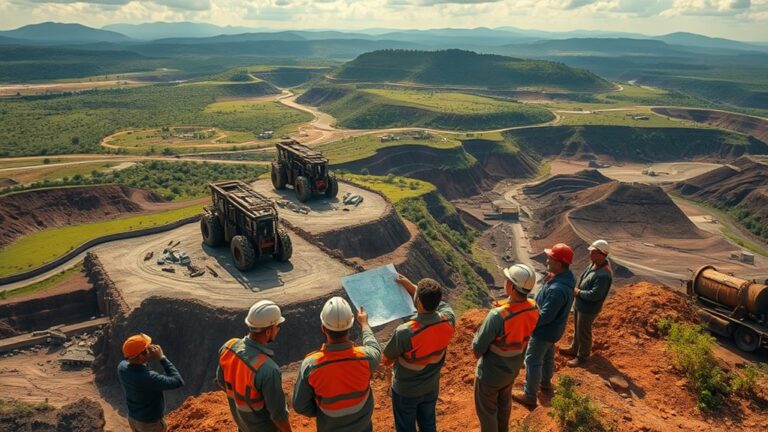
Future of Crypto Mining: What’s Next?
The future of crypto mining will be greatly influenced by technological advancements, sustainability efforts, and market trends. Innovations like AI and next-generation ASICs are enhancing efficiency and performance. Meanwhile, there is growing concern over the environmental impact of mining, leading to a push for renewable energy sources. As regulatory landscapes evolve, miners must adapt to new guidelines while leveraging advanced technologies. These factors will shape the industry’s direction and profitability moving forward. Additional insights await exploration.
Key Takeaways
- Advancements in AI and ASIC technology will enhance mining efficiency and reduce operational costs, driving future profitability.
- The adoption of renewable energy sources will mitigate the environmental impact of mining and align with sustainability initiatives like the Crypto Climate Accord.
- Market growth is anticipated due to rising institutional investments and cryptocurrency adoption in developing nations, expanding opportunities for miners.
- Innovations in cooling technologies and modular data centers will improve hardware longevity and operational flexibility, making mining more scalable.
- Evolving regulations will require miners to adopt sustainable practices while staying informed on consumer protection measures and compliance requirements.
Technological Advancements in Crypto Mining

As the landscape of cryptocurrency mining evolves, technological advancements play an essential role in enhancing operational efficiency and sustainability. The integration of artificial intelligence (AI) allows for real-time data analysis and predictive maintenance, greatly improving mining operations.
Additionally, advancements in application-specific integrated circuits (ASICs) have led to chips with smaller footprints, resulting in increased computing power and reduced energy consumption. High-Performance Computing (HPC) is also gaining traction, enabling miners to diversify revenue streams.
Innovations in cooling technologies, such as immersion and liquid cooling, enhance hardware lifespan and efficiency. Moreover, custom software solutions facilitate real-time management, optimizing airflow and minimizing heat buildup, ultimately leading to more effective mining operations in a competitive environment. Furthermore, choosing the right cryptocurrency mining software can significantly impact profitability by allowing miners to connect to blockchains efficiently and optimize earnings.
Sustainability and Environmental Impact

The sustainability and environmental impact of cryptocurrency mining have become increasingly important topics as the industry continues to grow. Mining activities, particularly Bitcoin, consume vast amounts of energy and contribute notably to carbon emissions. Many operations still rely on fossil fuels, especially in regions with cheap electricity.
| Issue | Details |
|---|---|
| Energy Consumption | Bitcoin mining uses approximately 63 terawatt-hours annually. |
| Air Pollution | Linked to increased PM2.5 pollution affecting nearly 1.9 million Americans. |
| Electronic Waste | Mining hardware generates e-waste comparable to that of the Netherlands. |
Transitioning to renewable energy sources and adopting sustainable practices could mitigate these environmental challenges. Initiatives like the Crypto Climate Accord aim to promote a carbon-neutral future for the industry. Implementing sustainable mining techniques could further enhance the industry’s environmental performance.
Economic and Market Trends

Economic and market trends in the cryptocurrency mining industry reveal a dynamic landscape shaped by various factors influencing growth and investment.
It is projected that the global cryptocurrency mining market will expand from $2.45 billion in 2024 to $8.24 billion by 2034, at a CAGR of 12.90%. Economic instability often drives demand for cryptocurrencies, as they provide a stable alternative during financial crises.
Additionally, developing nations are increasingly adopting digital currencies, enhancing market growth. Institutional investment is rising, adding credibility to the sector. As miners adapt to rising operational costs, profitability will largely depend on their ability to leverage new technologies and renewable energy sources.
However, regulatory scrutiny and market volatility pose challenges to widespread acceptance. As public miners expand their operations and new technologies emerge, the future of crypto mining remains closely linked to these evolving economic trends.
Operational Innovations in Mining

Innovations in operational practices are transforming the cryptocurrency mining landscape, enhancing efficiency and sustainability. Key advancements include the development of next-generation ASICs, which greatly improve energy efficiency and performance. Additionally, artificial intelligence plays an essential role in optimizing mining operations through predictive analytics. These innovations are further supported by the growing importance of selecting the right GPU based on hash rate, which can significantly impact mining profitability.
| Innovation | Description | Impact |
|---|---|---|
| Technological Advancements | 3nm and 2nm chips enhance performance and efficiency | Reduced energy consumption |
| Innovative Cooling Systems | Airflow maximization reduces traditional cooling needs | Lower operational costs |
| Renewable Energy Adoption | Increased use of green energy sources | Minimized environmental impact |
| Modular Data Centers | Scalable designs adapt to different energy strategies | Improved operational flexibility |
These innovations collectively contribute to a more sustainable and effective mining environment.
Regulatory Developments and Their Implications

As the cryptocurrency mining industry evolves, regulatory developments are becoming increasingly significant in shaping its future.
Recent clarifications from the SEC indicate that proof-of-work (PoW) mining activities, including self-mining and mining pools, do not fall under federal securities laws. However, the exemption has limitations, as other activities may still be subject to regulation.
The SEC’s new leadership is fostering a more crypto-friendly stance, with plans for roundtable discussions to define security in cryptocurrencies.
State-level regulations remain complex, with local governments scrutinizing mining for environmental impacts.
As global perspectives on energy consumption grow, the industry is encouraged to adopt sustainable practices, highlighting the need for a balanced regulatory approach to guarantee both profitability and environmental responsibility. Additionally, as the regulatory landscape evolves, it is crucial for miners to stay informed about consumer protection measures that may influence their operations.
Frequently Asked Questions
What Skills Are Needed to Start a Career in Crypto Mining?
To start a career in crypto mining, individuals need skills in algorithms, programming, hardware management, market analysis, risk management, regulatory compliance, cybersecurity, and an understanding of blockchain principles, ensuring a well-rounded foundation for success.
How Does Mining Difficulty Affect Individual Miners’ Earnings?
Mining difficulty directly impacts individual miners’ earnings by increasing competition and operational costs. As difficulty rises, miners earn fewer Bitcoins, necessitating investments in advanced equipment and efficient energy sources to maintain profitability amidst challenging conditions.
Can Mining Hardware Be Repurposed for Other Uses?
Despite concerns about outdated technology, mining hardware can be repurposed effectively for various applications, including computational tasks, education, and sustainability initiatives, ultimately reducing e-waste while generating additional revenue streams and promoting environmentally friendly practices.
What Are the Risks Associated With Investing in Mining Operations?
Investing in mining operations involves risks such as price volatility impacting profitability, regulatory uncertainties that may increase costs, environmental concerns affecting public perception, and technological advancements that could obsolete existing equipment, leading to financial losses.
How Do Global Events Impact Crypto Mining Profitability?
Global events greatly influence crypto mining profitability by affecting inflation, energy prices, and regulatory environments. Political instability can shift economic conditions, while technological advancements and environmental concerns also play essential roles in shaping mining operations’ viability.
Conclusion
As the landscape of crypto mining continues to evolve, the future remains uncertain yet intriguing. Technological advancements promise efficiency, while sustainability efforts seek to minimize environmental harm. Economic fluctuations and regulatory changes could reshape the industry in unexpected ways. Innovations in operations may enhance productivity, but challenges linger on the horizon. Will these developments lead to a more sustainable and profitable future for crypto mining, or will unforeseen obstacles emerge? Only time will reveal the answers.












